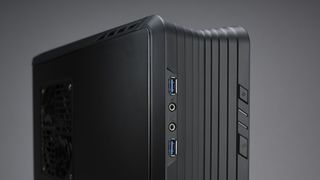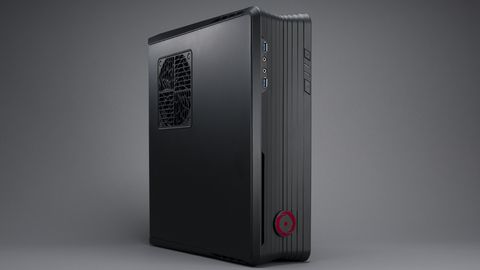TechRadar Verdict
Boutique gaming PCs are rarely perfect. The Chronos Z, however, is. When the biggest flaw on the list is "it's a little too loud," you pretty much have a perfect machine.
Pros
- +
Well future-proofed
- +
Excellent performance
- +
Fantastic value
Cons
- -
Tight part placement
- -
Loud and hot
- -
Few component options
Why you can trust TechRadar
The first thing I think to myself whenever I see the specs on a new PC is "could I have built this to perform even better for less money?" Too often, the answer, sadly, is yes.
Take the Falcon Northwest Tiki or Digital Storm Bolt II for example. Those are both wonderful PCs. The former is one of the best looking machines I've laid eyes on, while the latter makes up for its plain exterior by packing great components on the inside of its case.
Both of them, however, could be built for well under their $6,000 (about £3,700, AU$6,900) and $4,000 (about £2,500, AU$4,500) asking prices, respectively. I can say with absolute certainty that, unless you have a friend at Nvidia, it's near impossible to buy every component in the Chronos Z, Origin's new mini-ITX offering, for less than its $4,199 (about £2,584, AU$4,794) price tag.

But being a boutique machine at an almost-DIY-desktop price is really only part of the Chronos Z's appeal. Packing a GTX Titan Z GPU, this is by far the most power I've ever seen squeezed into the mini-ITX form factor.
That kind of power comes at a cost, though. No, I'm not referring to the price tag, but rather its incessant humming and potentially fire-hazard heat levels. First thing's first, though. Let's look at the outside of the box.
Design
The Chronos Z is available in four cases: The squat Corsair 250D; sleek Silverstone RVZ01; average-sized Corsair 350D; and trash bin-shaped Silverstone FT03.
The model sent to TechRadar was housed in a Silverstone RVZ01 case, my favorite option. It's not the most upgradeable of the lot – in fact, getting in and out turned out to be quite a struggle – but the vertical gray slits that perforate the top and bottom of the box are too appealing to resist.
Three of the four cases have front-facing USB 3.0 ports and out of the pack, but only the RVZ01 has the ability to lay sideways like its console rivals, the PS4 and Xbox One. Choose the FT03, though, and Origin will paint it red, white or pink for an extra $300 (about £180, AU$350). Choose any of the other cases and, well, what you see is what you get.

Along the sides you'll find three fans, two used exclusively for the GPU and one for the cooling unit. These are, as you can imagine, completely useful for a running system. The fans make more noise than I'd like – it's a near-constant hum whenever the system is on.
Also, this adds considerable heat to the surrounding area. It's a trade-off most enthusiasts would be more than happy to make (auditory discomfort for a little extra power comes with the territory). But, if you live in a poorly ventilated apartment, you might want to crank the AC a bit higher during the summer months to compensate for the additional warmth.
In it to win it
Getting inside the RVZ01's case was a bit of a problem without thumbscrews on the back panel. But one long search for a screwdriver later, and I was in.
The back panel slid out, but stayed attached due to the wire running to the 120mm cooling system. Everything you could possibly want to see is available on first look. The only component out of reach, though, is arguably one of the most important: the GPU.

It'd be easy to dock points for inaccessibility here. Upgrading can already be a tedious task without having to dismantle your entire machine and put it back together. But the Titan Z card makes a strong case that, honestly, any upgrades in this area won't happen for a very long time.
The other possible weakness of the Silverstone case is the lack of bays for 3.5-inch hard drives. Again, though, Origin uses the space to pack a single Seagate 4TB drive next to a 1TB Samsung 840 EVO SSD, ensuring that internal storage will never be an issue.
Nick Pino is Managing Editor, TV and AV for TechRadar's sister site, Tom's Guide. Previously, he was the Senior Editor of Home Entertainment at TechRadar, covering TVs, headphones, speakers, video games, VR and streaming devices. He's also written for GamesRadar+, Official Xbox Magazine, PC Gamer and other outlets over the last decade, and he has a degree in computer science he's not using if anyone wants it.

Researchers produce thinnest sheet of metal ever using a 100-year old Japanese technique — Goldene could pave way for super catalysts, ultra high density optical storage and much more

Thomas & Uber Cup 2024: how to watch BWF badminton online

A mystery Wear OS watch has just surfaced as the Pixel Watch 3 gets closer

